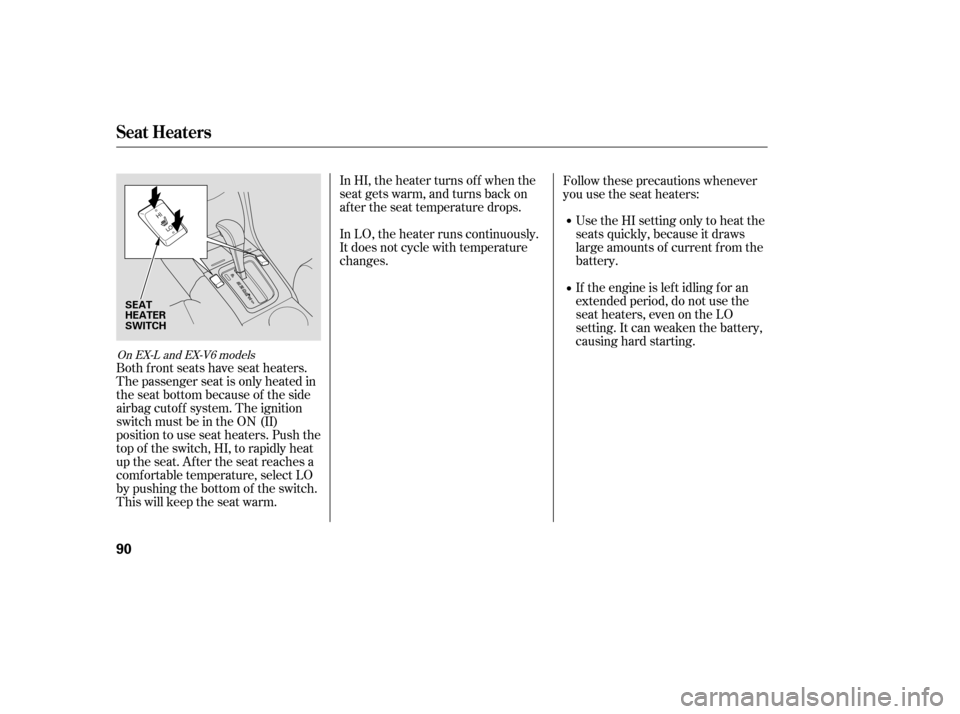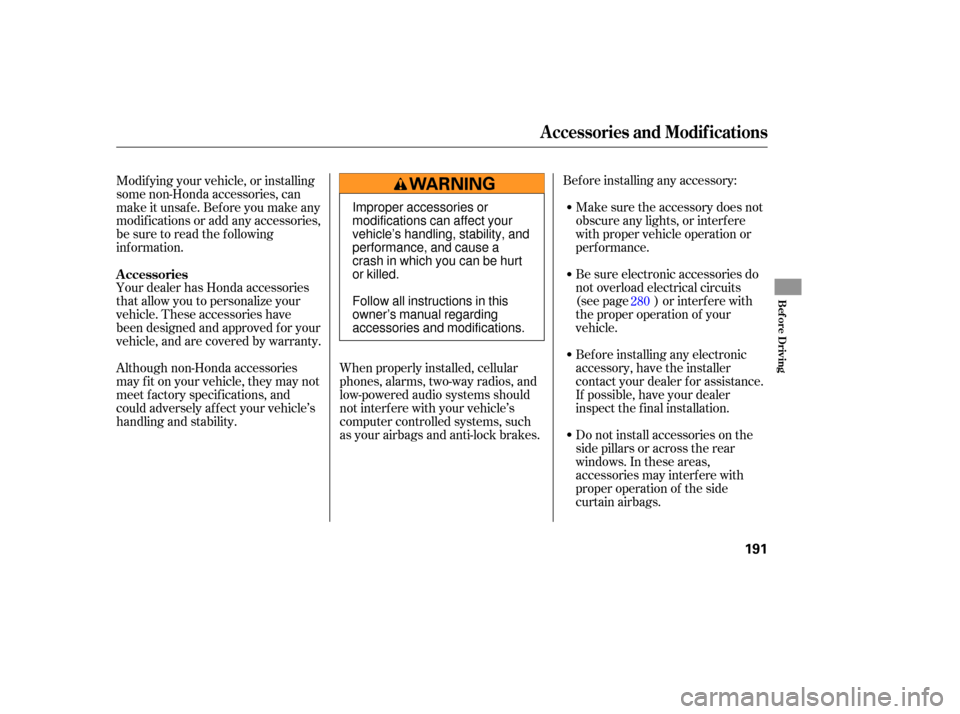Page 58 of 319
�Î�Î
�Î
If equipped.
:
Canadian models
Instrument Panel
56
LOW OIL PRESSURE INDICATOR
CRUISE MAIN INDICATOR
VEHICLE STABILITY ASSIST (VSA)
SYSTEM INDICATOR
CRUISE CONTROL INDICATOR
ANTI-LOCK BRAKE SYSTEM
(ABS) INDICATOR
SEAT BELT REMINDER
INDICATOR
SUPPLEMENTAL
RESTRAINT SYSTEM
INDICATOR
SIDE AIRBAG OFF INDICATOR
LOW
FUEL INDICATOR
HIGH BEAM INDICATOR
PARKING BRAKE AND BRAKE
SYSTEM INDICATOR
TURN
SIGNAL AND HAZARD
WARNING INDICATORS
IMMOBILIZER
SYSTEM INDICATOR
MALFUNCTION
INDICATOR LAMP
CHARGING
SYSTEM
INDICATOR (P.57)
(P . 59)
LIGHTS ON INDICATOR
(p.60 )
( P.57)
(P.57)
(P.59) (P.60)
(P.60)
(P.58) (P.62)
VSA ACTIVATION INDICATOR (P.62)
(P.62) (P.62)
(P.59)
MAINTENANCE MINDER
INDICATOR (P.61)
DOOR AND TRUNK OPEN
MONITOR (P.61)
(P.57)
(P.58)
SECURITY SYSTEM INDICATOR
WASHER
LEVEL INDICATOR (P.60)
(P.61)
DAYTIME RUNNING LIGHTS INDICATOR (P.60)
(P.58)
EX-V6 with A/T model is shown.
�����—�����—�����y�
�������������y���
�(���%�������y���������y
Page 60 of 319

This indicator has two functions: This indicator c
omes on when you
turn the ignition switch to the ON
(II) position. If it comes on at any
other time, it indicates that the
passenger’s side airbag has
automatically shut off. For more
information, see page .
Itcomesonwhenyouturnthe
ignition switch to the ON (II)
position. It is a reminder to check
the parking brake. A beeper
sounds if you try to drive with the
parking b
rake not fully released.
Driving with the parking brake not
fully released can damage the
brakes and tires.
If it stays on after you have fully
released the parking brake while
the engine is running, or if it
comes on while driving, there
could be a problem with the brake
system. For more information, see
page . This indicator comes on for several
seconds wh
en you turn the ignition
switch to the ON (II) position. If it
comes on at any other time, it
indicates a poten tial problem with
your front airbags. This indicator will
also alert you to a potential problem
with your side airbags, passenger’s
side airbag automatic cutoff system,
side curtain airbags, automatic seat
belt tensioners, driver’s seat position
sensor, or the front passenger’s
weight sensors. For more
info rmation, see page .
1.
2.
2829
278
Parking Brake and Brake System
Indicator
Supplemental Restraint
System Indicator
Side Airbag Of f Indicator
Instrument Panel Indicators
58
U.S. Canada U.S. Canada
�����—�����—�����y�
�������������y���
�(���%�������y�������
�y
Page 69 of 319
�Î
�Î
�Î
�Î �Î
�Î
To
use the horn, press the pad around the ‘‘H’’ logo.
If equipped.
1:
2:
Controls
Near the Steering Wheel
Instru m ent sand Cont ro ls
67
EX-V6 model without navigation system is shown. CRUISE
CONTROLS
TILT/TELESCOPIC ADJUSTMENT
REMOTE
AUDIO
CONTROLS
HEADLIGHTS/
TURN
SIGNALS WINDSHIELD
WIPERS/WASHERS
REAR WINDOW
DEFOGGER AUDIO SYSTEM
HAZARD
WARNING
BUTTON PASSENGER
AIRBAG OFF
INDICATOR
(P.69) HORN
MOONROOF
SWITCH
(P.94) (P.73)INSTRUMENT
PANEL
BRIGHTNESS (P.71)
(P.68)
(P.29)
(P.71)
(P.72)
SEAT HEATERS
(P.90)
(P.171)
(P.212) (P.124)
(P.175)
VEHICLE
STABILITY ASSIST
OFF SWITCH
1
2 2
2
�����—�����—�����y�
�������������y���
�(���%�������y���������y
Page 91 of 319

To release the seat-back from inside
the trunk, pull the release under the
trunk panel. Push the seat-back
down, then let go of the release.
To lock the seat-back upright, push it
firmly against the trunk panel. Make
sure it is latched in place by pulling
on the top of the seat. Make
sure that the folded seat-back
does not interfere with the front
passenger’s seat-back. This will
cause the front passenger’s weight
sensors to work improperly (see
page ). Also check the passenger
airb ag off indicator to assu re proper
operation of the passenger’s
advanced front airbag.
Do not put any heavy items on the
seat-back when it is folded. Make
sure all items in the trunk, or
items extending through the opening
into the back seat, are secured.
Looseitemscanflyforwardand
cause injury if you have to brake
hard. See on page
.
Never drive with the seat-back
folded down and the trunk lid open.
See on
page .
Make sure all rear shoulder belts are
positioned in f ront of the rear seat-
back, and the center shoulder belt is
re-positioned in the guide whenever
the seat-back is in its upright position.
Be sure the center shoulder belt is
not twisted. 50
25
193
Seats
Carrying Cargo
Carbon Monoxide HazardInst rument s and Cont rols
89
Pull
�����—�����—�����y�
�����������
�y���
�(���%�������y���������y
Page 92 of 319

In LO, the heater runs continuously.
It does not cycle with temperature
changes. In HI, the heater turns of f when the
seat gets warm, and turns back on
after the seat temperature drops.Follow these precautions whenever
you use the seat heaters:
Use the HI setting only to heat the
seats quickly, because it draws
large amounts of current f rom the
battery.
If the engine is lef t idling f or an
extended period, do not use the
seat heaters, even on the LO
setting. It can weaken the battery,
causing hard starting.
Both front seats have seat heaters.
The passenger seat is only heated in
the seat bottom because of the side
airbag cutoff system. The ignition
switch must be in the ON (II)
position to use seat heaters. Push the
top of the switch, HI, to rapidly heat
up the seat. After the seat reaches a
comf ortable temperature, select LO
by pushing the bottom of the switch.
This will keep the seat warm.
On EX-L and EX-V6 models
Seat Heaters
90
SEAT
HEATER
SWITCH
�����—�����—�����y�
�������������y���
�(���%�������y���������y
Page 193 of 319

When properly installed, cellular
phones, alarms, two-way radios, and
low-powered audio systems should
not interfere with your vehicle’s
computer controlled systems, such
as your airbags and anti-lock brakes. Befo
re installing any accesso ry:
Make sure the accessory does not
obscure any lights, or interfere
with proper vehicle operation or
performance.
Modifying
your vehicle, or installing
some non-Honda accessories, can
make it unsafe. Before you make any
modifications or add any accessories,
be sure to read the following
info rmation.
Your dealer has Honda accessories
that allow you to personalize your
vehicle. These accessories have
been designed and approved for your
vehicle, and are covered by warranty. Be sure electronic accessories do
not overload electrical circuits
(see page ) or interf ere with
the proper operation of your
vehicle.
Although non-Honda accessories
may f it on your vehicle, they may not
meet f actory specif ications, and
could adversely af f ect your vehicle’s
handling and stability. Bef ore installing any electronic
accessory, have the installer
contact your dealer for assistance.
If possible, have your dealer
inspect the f inal installation.
Do not install accessories on the
side pillars or across the rear
windows. In these areas,
accessories may interf ere with
proper operation of the side
curtain airbags.280
A ccessories
A ccessories and Modif ications
Bef ore Driving
191
Improper accessories or
modifications can affect your
vehicle’s handling, stability, and
performance, and cause a
crash in which you can be hurt
or killed.
Follow all instructions in this
owner’s manual regarding
accessories and modifications.
�����—�����—�����y�
�������������y���
�(���%�������y���
�����y
Page 194 of 319

Some examples are:Larger or smaller wheels and tires
can interf ere with the operation of
your vehicle’s anti-lock brakes and
other systems.
If you plan to modif y your vehicle,
consult your dealer. Modif ying your steering wheel or
any other part of your vehicle’s
safety features can make the
systems inef f ective.
Removing parts f rom your vehicle,
or replacing components with
non-Honda components could
seriously af f ect your vehicle’s
handling, stability, and reliability.
Lowering your vehicle with a
non-Honda suspension kit that
signif icantly reduces ground
clearance can allow the
undercarriage to hit speed bumps
or other raised objects, which
could cause the airbags to deploy.
Raising your vehicle with a
non-Honda suspension kit can
af f ect the handling and stability.
Non-Honda wheels, because they
are a universal design, can cause
excessive stress on suspension
components.
Modif ying Your Vehicle
A ccessories and Modif ications
192
�����—�����—�����y�
�������������y���
�(���%�������y���
�����y
Page 197 of 319

Store or secure all items that could
be thrown around and hurt
someone during a crash.
Do not put any items on top of the
rear shelf. They can block your
view and be thrown around the
vehicle during a crash.
In addition, the total weight of the
vehicle, all passengers, accessories,
cargo, and trailer tongue load must
not exceed the Gross Vehicle
Weight Rating (GVWR) or the Gross
Axle Weight Rating (GAWR). Both
areonalabelonthedriver’s
doorjamb.
Distribute cargo evenly on the
floor of the trunk, placing the
heaviest items on the bottom and
as far forward as possible. Tie
down items that could be thrown
about the vehicle during a crash or
sudden stop.
Ifyoufolddownthebackseat,tie
down items that could be thrown
about the vehicle during a crash or
sudden stop.
If you carry large items that
prevent you from closing the trunk
lid,
exhaust gas can enter the
pa ssenger area. To avoid the
possibility of
, follow the instructions
on page .
Be sure items placed on the f loor
behind the f ront seats cannot roll
under the seats and interf ere with
proper operation of the pedals, the
front seats, or the advanced front
airbags.
Keep the glove box closed while
driving. If it is open, a passenger
could injure their knees during a
crash or sudden stop.
50
CONT INUED
Carrying Cargo
Carrying Cargo in the Trunk or on
a Roof Rack
Carrying Items in the Passenger
Compartment
carbon monoxide
poisoning
Bef ore Driving
195
�����—�����—�����y�
�������������y���
�(���%�������y���
�����y